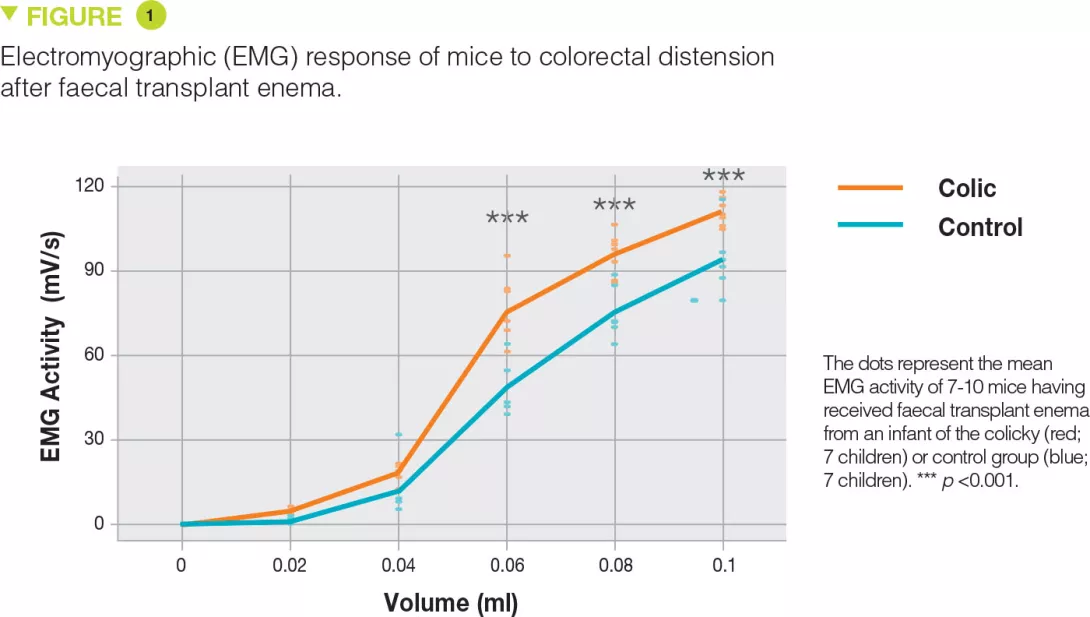Stool contents of colicky infants induce visceral hypersensitivity in mice
Commented article - Children section
By Pr. Emmanuel Mas
Gastroenterology and Nutrition Department, Children’s Hospital, Toulouse, France
Sources
This article is based on scientific information
Sections

About this article
Commentary on the original publication by Eutamène et al. (Neurogastroenterol Motil 2017)
The pathophysiology of infantile colic is poorly understood, though various studies report gut microbiota dysbiosis in colicky infants. Our objective was to test the hypothesis that colic-related dysbiosis is associated with visceral hypersensitivity, triggered by changes in intraluminal content. Faecal samples from seven colicky and seven non-colicky infants were studied.
Faecal supernatants (FS) were infused into the colons of C57/Bl6 mice (n=10/specimen). Visceral sensitivity was subsequently assessed in the animals by recording their abdominal muscle response to colorectal distension (CRD) by electromyography (EMG). Serine and cysteine protease activities were assessed in FS using specific substrates. Infant faecal microbiota composition was analysed by 16S rRNA gene pyrosequencing following DNA extraction. FS from colicky infants triggered higher EMG activity than FS from non-colicky infants in response to both the largest CRD volumes and overall, as assessed by the area under the curve of the EMG across all CRD volumes. Infant crying time strongly correlated with mouse EMG activity.
Microbiota richness and phylogenetic diversity were increased in the colicky group, without prominent microbial composition alterations. Only Bacteroides vulgatus and Bilophila wadsworthia were increased in the colicky group. The abundance of Bacteroides vulgatus positively correlated with visceral sensitivity.
No differences were found regarding protease activities. Luminal contents from colicky infants trigger visceral hypersensitivity, which may explain the excessive crying behaviour of these infants. Additional studies are required to determine the nature of the compounds involved, their mechanism of action, and the potential implications of intestinal microbiota in this age group. [1]
What is already known about this topic?
Infantile colic is a functional gastrointestinal disorder, defined by the Rome criteria. The pathophysiology is still poorly known although a painful intestinal mechanism is suspected. Studies suggest that a disturbance of the gut microbiota, an increase in gut permeability, and lowgrade intestinal inflammation are involved in visceral hypersensitivity. These factors are involved in the pathophysiology of irritable bowel syndrome. In this syndrome, an abnormality of the protease/ antiprotease balance contributes to visceral hypersensitivity and low-grade inflammation.
What are the main results of this study?
The aim of this study was to investigate whether a disturbance of the gut microbiota, associated with an increase in gut proteases, is capable of inducing visceral hypersensitivity. Breastfed infants, aged 1-4 months, were included. There was no difference in pregnancy duration, birth weight, or family history of allergy between the colicky group (n = 7) and control group (n = 7). According to the criteria (Rome III criteria), only the mean duration of crying differed, with 240 ± 95.95 minutes (colicky) versus 24.04 ±19.65 minutes (control).
Rectal faecal transplant enemas from colicky infants induced significant visceral hypersensitivity during rectal distension with larger volumes (+55%, p <0.001 with 0.06 mL; +27%, p <0.001 with 0.08 mL, and +19%, p <0.001 with 0.1 mL) (Figure 1), as well as a better overall response (increase in area under the curve by +33%, p <0.001). In addition, there was a positive correlation between the duration of crying and these distension volumes (Figure 2).
In contrast, there was no difference in protease levels (serine, trypsin-like, and elastase-like) between both groups.
Finally, the analysis of the microbiota showed an increase in Bacteroides vulgatus and Bilophila wadsworthia diversity with an abundance in children with infantile colic. The relative abundance of B. vulgatus was positively associated with mouse hypersensitivity (p = 0.021), but not significantly associated with the duration of crying (p = 0.067).

Key points
-
The stools of colicky infants trigger visceral hypersensitivity, as in irritable bowel syndrome.
-
Further studies are needed to determine the compounds involved, their mechanism of action, and their link with a disturbance of the gut microbiota.
What are the practical consequences?
This study shows that a component of the stool contents of colicky infants is capable of inducing visceral hypersensitivity in mice, involving either an increase in a nociceptive compound or a decrease in an antinociceptive compound. This is not an impaired proteolytic balance, however this compound might be induced by a different gut microbiota. Further studies are needed to identify this compound and the mechanism of action.

Conclusion
Faecal microbiota enema transplants from colicky infants to mice can induce visceral hypersensitivity. This is promoted by a painful abdominal mechanism and the direct or indirect involvement of the gut microbiota in the pathophysiology of infantile colic. This model could be used to determine which metabolic pathways are modified by a disturbance of the gut microbiota and involved in infantile colic.






